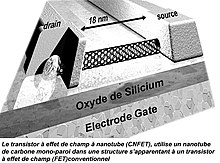Nanotube
A nanotube ( English Nanotube ) is an elongated hollow body with a diameter of less than 100 nanometers . Carbon nanotubes (CNTs for short) are particularly important and well-studied , but there are also nanotubes made of boron nitride , titanium dioxide , sulfides ( molybdenum and tungsten disulfide , copper (II) sulfide ) and halides ( nickel chloride , cadmium chloride , cadmium iodide ).
The production and possible use of nanotubes is intensively researched in the context of nanotechnology : In 2002, around 3,000 scientific publications on nanotubes were published.

properties
Of all mentioned in the introduction materials long been known that, analogous to carbon in the form of graphite , layered structures can form. Nanotubes can also be made from plastics .
Typically, the diameter of a nanotube is only a few nanometers; the inner tubes in multi-walled nanotubes can be as thin as 0.3 nanometers. This means that they are only a few ten-thousandths as thick as a human hair. With carbon nanotubes , lengths of 20 centimeters have already been achieved. However, lengths of a few micrometers are typical .
Nanotubes can be single-walled or multi-walled and the wall can form both a closed ring and a spiral structure. The ends of the tubes can be closed or open and the inside can be empty or filled. Carbon nanotubes z. B. could, at least partially, be filled with liquid lead . Depending on the production conditions, whole bundles or threads of nanotubes are also created.

Applications
Scientists are thinking, for example, of a space elevator that is connected to the earth's surface by nano ropes. On such a rope a space elevator could e.g. B. transport satellites into space or supply space stations inexpensively.
Another area of application is to be in the batteries of electric cars. Researchers from Stanford University and Hanyang University in Ansan are working with Korean battery manufacturer LG Chem to research a method to manufacture batteries from nanotubes, which would increase the battery life from the current 30 minutes to three to four hours.
criticism
Critics point out that the risks of nanotechnology have so far not been adequately researched. There is evidence that certain nanotubes, similar to asbestos fibers , can promote the development of cancer.
Research on health risks and effects on living organisms is summarized under the heading of nanotoxicology .
See also
Web links
- Criticism of nanotubes production by the "Coordination against BAYER dangers" initiative
- Nanotubes make mobile nanotubes in modern electric cars
Individual evidence
- ↑ Direct Synthesis of Long Single-Walled Carbon Nanotube Strands . Retrieved from sciencemag.org on September 18, 2014
- ↑ Technology Review: Nanotubes make people mobile. In: Technology Review. Retrieved June 1, 2016 .
- ↑ Drucksache 17/3557 , Small question to the Bundestag on October 27, 2010 on “Status and Perspectives of Nanotechnologies”. On: bundestag.de (PDF; 91 kB)
- ↑ Criticism of the approval process for nanotube production at Bayer . On: heise.de on December 25, 2010